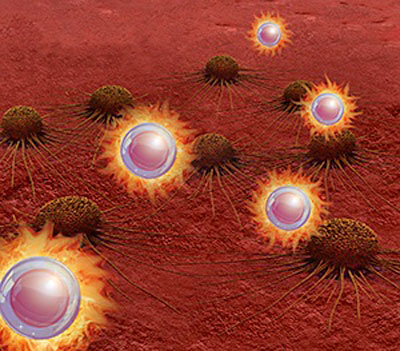|

29 August 2011
from
NatureAsia Website
|
Optimizing the conversion of
electromagnetic energy into heat allows the production of
nanoparticles that can destroy cancer cells. |

Illustration of
core-shell magnetic nanoparticles generating heat
under an
electromagnetic field and killing cancer cells by hyperthermia
The practical utility of magnetic
materials was identified thousands of years ago when lodestones were
first used in compasses to navigate the oceans.
Today, magnetism forms the basis for
many of the technologies we take for granted, as well as some with
decidedly futuristic applications.
Jinwoo Cheon and colleagues from
Yonsei University, the Korea Basic Science Institution and the
Yonsei University College of Medicine in Korea have now worked out
how to maximize the heat produced by magnetic nanoparticles to
extraordinary effect in the treatment of cancer.1
When magnetic particles are exposed to electromagnetic waves,
magnetic spin relaxation processes lead to the production of heat
which, if great enough, can kill cancer cells.
Hyperthermia as it is
known can also be generated in nonmagnetic nanoparticles, but the
advantage of the magnetic approach is that the method can be used
much deeper in the body. The challenge of magnetically induced
hyperthermia is how to generate enough heat.
Cheon’s team used a theoretical model to probe the effect of
nanoparticle diameter, composition and magnetization on magnetic
heating power.
Doing so, they found optimal ranges for
heat generation.
To obtain nanoparticles with properties that
allowed them to respond in these ranges, the researchers fabricated
core-shell composite nanoparticles containing mutually coupled
‘soft’ and ‘hard’ magnetic components. The resultant nanoparticles
had a cobalt-iron oxide core and a manganese-iron oxide shell.
The utility of the nanoparticles in attacking human cancer cells was
tested by injecting a suspension of the nanoparticles into tumors
xenografted onto mice.
The mice were placed in a water-cooled
magnetic induction coil and exposed to an electromagnetic field for
10 minutes. In contrast to the control mice, which experienced a
multifold increase in tumor size over the next three weeks, the
tumors on the mice treated with the nanoparticles had completely
disappeared.
Only 75 μg of nanoparticles were
required for complete elimination of the tumor.
"In the continuation of our
research, we intend to explore other nanoparticle candidates
with enhanced heat generation capabilities. We will also test
the therapeutic efficacy of the approach in other tumor models
as well as in vivo toxicity assessment and mass production of
the nanoparticles," says Cheon.
Reference
Lee, J.-H.1, Jang, J.-T.1, Choi,
J.-S.1, Moon, S. H.1, Noh, S.-H.1, Kim, J.-W.1, Kim, J.-G.2,
Kim, I.-S.3, Park, K. I.3, Cheon, J.1 Exchange-coupled magnetic
nanoparticles for efficient heat induction. Nature Nanotechnol.
6, 418–422 (2011). |
article
Author affiliation
1. Department of Chemistry, Yonsei
University, Seoul 120-749, Korea
2. Division of Electron Microscopic Research, Korea Basic
Science Institution, Daejeon 305-333, Korea
3. Department of Pediatrics and BK21, Yonsei University College
of Medicine, Seoul 120-752, Korea
|

